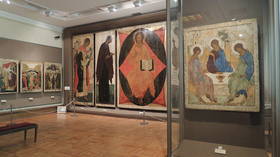Russian Orthodox Church takes possession of treasured icon


The Russian Orthodox Church will take possession of one of the most cherished pieces of Russian religious art, the ‘Trinity’ icon by medieval painter Andrey Rublev. After the 1917 revolution, the new anti-clerical government decided that the icon’s place was in a museum, while in modern Russia clerics have long sought its return.
The Church announced the icon’s pending relocation on Monday, citing a decision by Russian President Vladimir Putin. It will be presented to the public for worship at the Christ the Savior Cathedral in Moscow for one year, the brief statement said. The icon will then be moved to the Trinity Lavra of St. Sergius, a monastery in Moscow Region. The artwork was originally painted for a cathedral at the monastery in the first quarter of the 15th century.
‘Trinity’ is arguably the most recognizable piece of Russian medieval art. It shows three sitting angelic figures, with a cup placed at the center of the table in front of them. The scene is believed to display an Old Testament episode, when three angels visited the home of Abraham before the punishment of Sodom and Gomorrah, but also represents the Christian concept of the threefold nature of God.
The icon was removed from the Church’s possession by the Bolshevik government along with the Trinity Lavra of St. Sergius in 1920. Nine years later it was moved to the Tretyakov Gallery in Moscow.
Starting in the late 1990s, ‘Trinity’ was placed on display for one day each year at a special church attached to the gallery, where it could serve its original religious purpose. Gallery workers said they were concerned that the historic piece of art could not be properly preserved outside its walls.
That notion led to a heated debate last year, when the Culture Ministry granted special permission to transfer the icon for two days to the Trinity Lavra at the request of the Church. The move came as believers marked the 600th anniversary of the translation of the relics of St. Sergius, which happened a century after his death in 1322.
The Church has pledged to observe instructions from leading Russian museums on how to best preserve the national treasure.